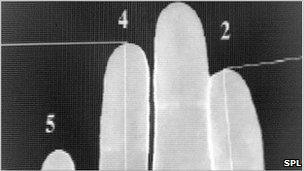Finger length clue to motor neurone disease
- Published

A link was found with a longer ring finger relative to the index finger
The length of a person's fingers could reveal their risk of motor neurone disease, according to a study.
UK researchers measured the finger length of 110 people, including 47 with amyotrophic lateral sclerosis (ALS), the most common form of the disease.
The study, external, in the Journal of Neurology, Neurosurgery and Psychiatry, suggests a link between a longer fourth finger relative to the index finger and ALS.
Experts say finger length cannot help screen for ALS and more work is needed.
The ratio between the fingers has already been linked to many traits, including sporting prowess and aggression, and is believed to be set in the womb.
Experts believe a longer fourth finger relative to the index finger could be partly determined by how much exposure a baby has to the male hormone testosterone before birth.
Indeed, men often do have slightly longer ring fingers than index fingers, while women often do not.
And experts know that motor neurons need testosterone for survival and repair, and men who are born without the ability to use testosterone in the normal way develop a form of motor neuron degeneration.
Dr Brian Dickie of the Motor Neurone Disease Association, said: "This simple, but carefully conducted study raises some interesting questions about how events occurring before birth may increase the risk of developing motor neuron disease later in life.
"But it's important to remember that exposure to higher testosterone in the womb does not directly cause motor neuron disease.
"Many people with long ring fingers will never develop motor neuron disease as we believe there are numerous genetic and environmental factors that need to coincide in order to trigger the disease."